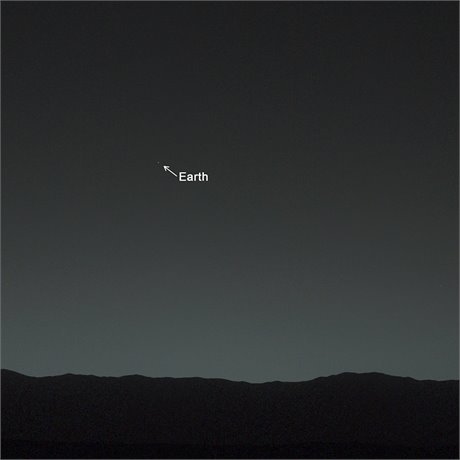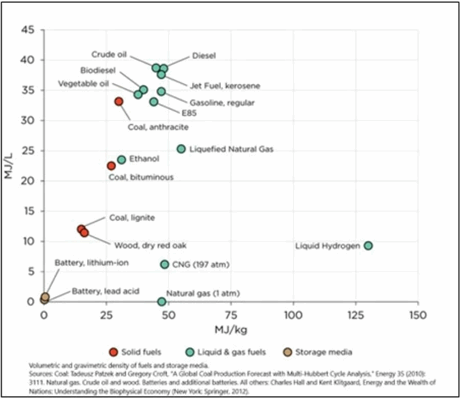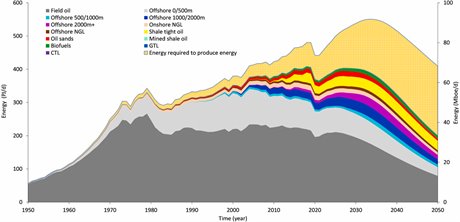Given that growth pushed us past planetary limits any growth green or black will push us over the edge so managed degrowth is our only option.
Looking at a picture of earth from Mars puts humankind into perspective. Earth is a tiny blue dot in the universe and the physical finite planetary limits are obvious. Looking at it I can see clearly what economists and many others don’t seem to see – the reality of biophysical limits. Kenneth Boulding nailed it when he said: “Anyone who believes in indefinite growth of anything physical on a physically finite planet is either a madman or an economist.

Limits to growth (LtG)
Ground-breaking work quantifying these biophysical limits was started in the 1970s by a small team of young systems ecologists and computer modellers at MIT. Funded by the Club of Rome and led by systems experts Dennis and Donella Meadows, they put numbers to the future of food, human population, resources, and industrial output. They used several different scenarios to look at future outcomes and they summarised it in a book titled Limits to Growth (LtG). Their forecasts under the business-as-usual scenario showed rapid rises of almost everything until around the 2020s and then sharp declines for non-renewable resources, food per capita, global population, and industrial output. The business-as-usual scenario is exactly the one humanity has taken. The most recent review in 2020 by Gaya Herrington, a partner in the firm KPMG, showed that the forecasts have been exceptionally accurate and we are now on the cusp of radical change.

The Limits to Growth team were confident that their work would lead to real change. They assumed that once people could see in numbers that mankind was on a destructive path major changes would result. The forecasts were controversial: while the work was celebrated by ecologists, many saw it as a threat to economic growth and their businesses that were dependent on growth in consumption. The manifestations of humanity exceeding limits to growth are now stark and abundant. An organisation called scientists warning made up of more than 20,000 scientists have been trying to highlight the multiple ecological crises occurring because we have exceeded limits. The latest warning to the world is clear: “if the world doesn’t change soon, doesn’t act soon, there will be catastrophic biodiversity loss and untold amounts of human misery”. Behind the warnings are a raft of papers and datasets showing drastic changes in almost everything in the biophysical world. The life supporting capacity of the planet is undergoing extreme stress especially in the last few decades. The voices of anger and despair from scientists are more extreme every day.
Ecological overshoot
There is a phenomenon becoming more obvious known as carbon tunnel-vision: the climate crisis gets the bulk of media coverage, but it is far from our only imminent existential environmental crisis. Climate change is just one of a raft of crises, all the crises are symptoms of one underlying driver and that is ecological overshoot. Humankind is exceeding multiple planetary boundaries, all symptoms of overshoot. Issues include soil erosion and degradation; groundwater pollution and depletion; deforestation; the massive rise of invasive species; the crash of biodiversity; fisheries collapse; eutrophication of rivers, lakes, and oceans; ocean acidification; the depletion of resources like phosphate; landuse change; decaying infrastructure; and a host of social issues are all symptoms of our overshoot of the carrying capacity of the planet.
The common denominator for all these crises, the driver of overshoot, is the availability of cheap energy in the form of fossil fuels. In a very short time, a century or two, particularly the last few decades, we squandered our one-off legacy of cheap incredibly high-density energy (fossil fuels). Like a young person receiving a huge endowment who then goes on a mammoth spending spree, the wealthy inhabitants of planet earth went on a fossil fuel powered binge, a party to end all parties, where we wasted incredible amounts of energy on frivolous monuments to stupidity like sky towers, cruise liners and Las Vegas to name a few of my favourite hates, with no thought for the future. Now the colossal weekend party is over, and we must face reality; that we have trashed the house, blocked the toilet, emptied the pantry and we have a hang-over.
Energy density

When considering future energy options, it is essential we understand the concept of energy density. The above graphic shows the energy density of energy sources and storage options that are a big part of our current lives in the wealthy world and reveals much. When we plot megajoules of energy by volume and by weight the high-density energies (mostly liquids like diesel and crude oil and jet fuel and gasoline) the fuels we use for transport are clustered together at the top. Also in this cluster are some renewable biofuels like biodiesel and vegetable oil but crucially these are very low or negative net energy options. These biofuels require as much or more fossil fuel energy to create them as you get energy out of them. The planting, harvesting, processing, and transporting energy costs mean you may as well have just burnt the fossil fuel rather than going through that whole process and tying up huge amounts of land in the activity. Right down at the bottom of the energy density graph is energy storage which shows that the battery systems that we have now, lithium and lead acid, are ten to twenty times lower in energy density than fossil fuels. A simple example is an EV where the battery weighs at least ten times more than the petrol needed to travel the same distance.
Energy return on energy invested (EROI)
To expand on the low net energy issue for biofuels mentioned above, this problem is also known as the energy cost of energy or commonly, the energy return on energy invested (EROI). This is an important concept to understand when considering any energy transition from fossil fuels. As an ecologist this concept is core to understanding the biological world. There are any number of examples, but the classic one used is a leopard chasing its prey on the savannah. The lesson is that if the leopard expends more energy chasing its prey than it gets back from consuming it, then it will not survive. This positive energy return is key to all life forms. In most cases the return needs to be more than just positive: it needs to be much higher. For every unit of energy expended there has to be a return of ten units of energy (an EROI of 10) to allow for all the other energy requirements other than chasing food. This idea translates directly to industrial human civilisation’s relationship with energy, indeed any resource: there must be a positive return on investment. There is another rule and that is, that for non-renewable resources the return on energy invested declines over time as you run down a resource.

In the case of fossil fuels, at least for liquid and gas, the energy return on energy invested has been going down. When we first discovered oil it bubbled up out of the ground: the EROI was high but over time the easy oil and gas was taken and it has been getting harder and harder to extract, so more and more energy is going in to extracting the energy so the net amount of energy available is effectively less. A recent paper (see graph above) shows that in 1950 the energy cost of oil was barely discernible, now it is 15%, and by 2050 it will be half of the gross output. This means you must keep discovering more and more oil to have the same amount of oil available for use. This has huge implications for everything we do including renewable energy because it is all made from fossil fuels so the EROI of the renewables declines as oil EROI declines.

The implications of the decline for the economy are massive as well because real GDP and energy use are locked together. Thus, an economy which is based on burning fossil fuels that requires more and more energy to go back into getting energy means the bit that’s left over for discretionary use is squeezed ever tighter. There is another multiplier effect making this situation even worse and that is the resource pyramid conundrum. This is closely associated to declining net energy and the fact that the materials we use for almost everything in our industrial civilisation, and especially for alternative energy sources, are declining. An example is copper, as ore concentrations decline you must dig up and process ever more material to get the same amount of the target. Now we must dig up and process 100 times more material than when copper deposits were first discovered. This increase in mining for less output just gets worse and worse as time goes on and the same goes for all the materials required for the transition from fossil fuels, not just the energy sources but all the new end uses like EVs and much more. For example in 1970 globally 27 gigatonnes of non-renewable material resources were used, and by 2017 that increased to 89 gigatonnes.
Oil, gas, and coal currently make up around 80% of our total energy use and clearly this must stop very soon. What are the alternatives? Currently they are hydroelectricity, nuclear energy, wind, and solar, and these have their own set of environmental and social impacts. For hydroelectricity most of the rivers that could be dammed have been dammed, and there are huge impacts of dammed rivers on freshwater biodiversity, geomorphology, and impacts felt downstream all the way to the ocean. If the dams create reservoirs, they have big greenhouse gas emissions decades afterwards as methane is released. These methane emissions often negate any gains for the atmosphere from new hydroelectricity schemes. Nuclear energy has some big issues, it’s expensive, it’s very slow to build and has unsolved waste issues. Wind and solar have big installation, environmental and material footprints, both have problems with intermittency and like most of the renewable options they need rebuilding every few decades. So, we must stop using the word renewable: it needs to be replaced with the word rebuildable or replaceable. Sure, the energy they are capturing is renewable, but the infrastructure to capture it is not. The other options like biofuels barely if ever break even on the energy that went into making them, and hydrogen is talked up by oil and gas industry people, but it is not an energy source, rather it is an energy transfer mechanism and a very inefficient one at that.
Pulling all this together the reality of continued growth, green or otherwise, is just not possible. First, there is a decline in the amount of net energy available from fossil fuels as we have passed peak oil and we have reducing EROI of oil and gas. So, we will have less energy available from fossil fuels but will need more and more as mineral ore concentrations decline with the resource pyramid conundrum. The increase in the amount of material mined will mean greater biodiversity and social impacts. Thus, to try to maintain current consumption levels will require ever more fossil fuels.
Transition to zero carbon
When we look at the progress so far in the transition to zero carbon it is clear that despite all of the extra materials and energy that have been expended on renewable energy construction and installation it has got us nowhere. The proportion of renewable energy in our total energy consumption here in New Zealand is unchanged since 1990 at around 28% and globally it has remained virtually unchanged. The problem is that as fast as we add renewable (rebuildable) energy we have no net gain because we add to our energy consumption at the same rate. The failure to get ahead is not surprising given that all these new energy sources require fossil energy at every step and the resource pyramid conundrum means more energy, but also because our lives become more energy intense. For example, here in New Zealand per capita energy consumption has doubled in my lifetime.
Some of the increased energy consumption is because more and more fossil fuels go into food production. Globally in 1970 around 43% of the energy came from fossil fuels and now it’s up to 62%. There is much talk of carbon capture and storage by fossil fuel companies’ sequestration but that will require using around half of the energy gained, and thus further enhance the already critical decline in energy return on investment. For all the reasons above, as well as entropy (everything degrading over time), going forward we are going to need more and more energy just to stay in the same place, let alone thinking about it increasing energy demand due to increasing population or consumption.
Analysing this energy conundrum led me to a surprising conclusion. I now realise that the goal of discovering a zero-carbon, non-harming energy source would not be the fantastic win for humanity I had long imagined. I now see it would probably be the worst thing that could happen. This is because it is the availability of cheap high-density energy that led to the multiple existential crises we face. Thus, it’s my belief that the only way we will stop destroying the life supporting capacity of our planet is when we run out of the energy to do so. For example, cheap energy would enable more and more intensive fishing out of the oceans, more and more intensive farming and its impacts on freshwater, and much more.
NZ’s flawed climate response
New Zealand is basing its response to the climate crisis on a plan to be carbon net-zero relying mainly on planting trees in this country and buying credits off-shore that are also based on sequestering carbon or avoiding release to the atmosphere. This approach is utterly flawed: only real reductions in emissions and consumption can possibly enhance the chances of avoiding ecological disaster. Net zero is a delusion. The carbon causing our climate problem today came from fossilised biology formed through ancient carbon cycles, mostly over the 200 million years of the Mesozoic era (ending 66 million years ago). Planting trees in today’s carbon cycle cannot ever mitigate fossil carbon. If we replanted the entire planet with trees, we would only mitigate the carbon lost from chopping the trees down not a single gram of fossil carbon. Even if we could replace all the vegetation on the planet we would at best only account for ten years of emissions and then we would just delay the inevitable one more decade.
We naively think (or are told) we can, in a few decades, replace our complex industrial energy system that took more than a century to build using cheap and abundant oil which is the most calorifically dense source of energy the world has ever known combined with unlimited mineral and material resources. It is not realistic to think this is in any way possible at a time when we have ever more expensive energy, declining fossil EROI, declining mineral densities, an unprecedented and growing human population, and almost all components of the life supporting capacity of the planet are teetering at the limits, and conflicts are growing over almost all resources. Green growth is neither achievable nor desirable. Even if it were achievable, we would just push all the teetering life supporting systems closer to the edge. Our only future involves switching from the current obsession with supply-side need for growth, and instead focus on demand-side reduction, or we will simply be transitioning from one race towards destruction (fossil) to another (renewable).
=====
Dr Mike Joy – Ecologist; Institute for Governance and Policy Studies, Victoria University of Wellington. Read more blogs from the Degrowth Aotearoa movement of activists and researchers.
- SEO Powered Content & PR Distribution. Get Amplified Today.
- PlatoAiStream. Web3 Data Intelligence. Knowledge Amplified. Access Here.
- Minting the Future w Adryenn Ashley. Access Here.
- Buy and Sell Shares in PRE-IPO Companies with PREIPO®. Access Here.
- Source: https://www.carbonnews.co.nz/story.asp?storyID=27720



